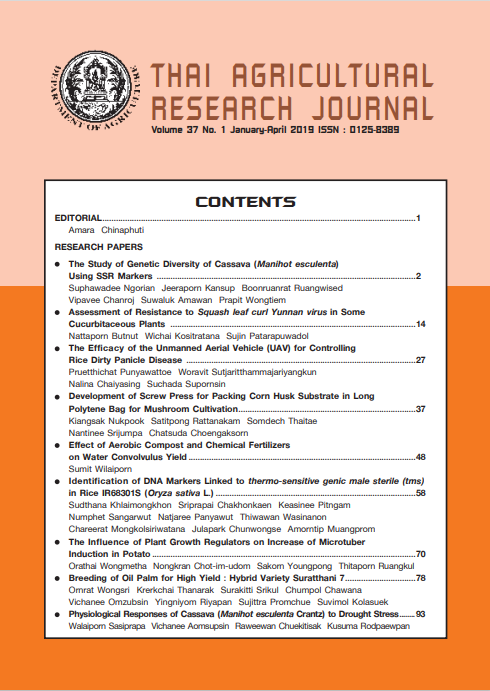Breeding of Oil Palm for High Yield : Hybrid Variety Suratthani 7
DOI:
https://doi.org/10.14456/thaidoa-agres.2019.10Keywords:
Oil palm, Suratthani hybrid 7Abstract
The oil palm breeding program of Department of Agriculture was supported by UNDP/ FAO from 1990 to 2011. The program received assistance in both outstanding and diverse germplasms and training in techniques for oil palm selection. The oil palm breeding program cycle II, carried out during 2003-2015, applied modified recurrent selection. The first step of this program was to determine and select the superior parents. Sixty-nine crosses between female mothers and male fathers palm were made. The second step was to carry out the progeny test and compared with that of the standard cross. The objective of this experiment was to select the best performance progeny cross as measured by fresh fruit bunch, oil yield and percentage of kernel per fruit . The oil palm progeny test of 23 crosses (D x T) of experimental trial 1 (BRD031) was carried out at Suratthani Oil Palm Research Center. The experimental design was RCB with 4 replications with 16 palm trees per plot and used Suratthani variety as standard cross. The variety Suratthani 7 or progeny number 198 (Deli dura x Tanzania tenera) produced significantly higher fresh fruit bunch (FFB) yield, bunch number, and bunch weight scored, compared to the others. Its yield, bunch/palm/year, bunch weight averaged from the third to the twelveth year of cultivation were with 4,458 kg/rai/year (195.5 kg/palm/year), 14.7 bunch/palm/year, and 15 kg/bunch respectively. Percentage of kernel/fruit was 11.1% more than the others and that of DOA standard selection. In addition mesocarp/fruit, shell/fruit and oil/bunch of the variety Suratthani 7 was 79.6, 9.3, and 23.6%, respectively. Likewise, the variety Suratthani 7 also showed 30.2% greater yield, compared to Suratthani 3 hybrid. The progeny number 198 was released and named Suratthani 7 hybrid in 2010 and has been recommended to farmer to plant in suitable area for oil palm cultivation.
References
อรรัตน์ วงศ์ศรี ศิริชัย มามีวัฒนะ ชุมพล เชาวนะ วราวุธ ชูธรรมธัช และชาย โฆรวิส. 2550. โครงการวิจัยปรับปรุงพันธุ์ปาล์มน้ำมันรอบที่ 2 ของกรมวิชาการเกษตร ระยะที่ 1 (2545-2548). ในรายงานผลงานวิจัยประจำปี 2547-2549. ศูนย์วิจัยปาล์มน้ำมันสุราษฎร์ธานี กรมวิชาการเกษตร.
อรรัตน์ วงศ์ศรี ศิริชัย มามีวัฒนะ เกริกชัย ธนรักษ์ สุรกิตติ ศรีกุล เพ็ญศิริ จำรัสฉาย
ชุมพล เชาวนะ วิชณีย์ ออมทรัพย์สิน ยิ่งนิยม ริยาพันธ์ สุจิตรา พรหมเชื้อ สุวิมล กลศึก
วิรัตน์ ธรรมบำรุง และวราวุธ ชูธรรมธัช. 2553. เอกสารเสนอปาล์มน้ำมันคู่ผสมหมายเลข 198 (เดลิ x แทนซาเนีย) เพื่อพิจารณาเป็นพันธุ์แนะนำปาล์มน้ำมันลูกผสมสุราษฎร์ธานี 7 ศูนย์วิจัยปาล์มน้ำมันสุราษฎร์ธานี กรมวิชาการเกษตร.
อรรัตน์ วงศ์ศรี สุวิมล กลศึก ชุมพล เชาวนะ ยิ่งนิยม ริยาพันธ์ เกริกชัย ธนรักษ์ และเตือนจิตร เพ็ชรรุณ. 2554. การเปรียบเทียบคู่ผสมปาล์มน้ำมันเพื่อคัดพันธุ์ลูกผสม. ในรายงานผลงานวิจัยประจำปี 2549-2553. ศูนย์วิจัยปาล์มน้ำมันสุราษฎร์ธานี กรมวิชาการเกษตร.
อรรัตน์ วงศ์ศรี สุวิมล กลศึก ชุมพล เชาวนะ ยิ่งนิยม ริยาพันธ์ เกริกชัย ธนรักษ์ และเตือนจิตร เพ็ชรรุณ. 2559. การเปรียบเทียบคู่ผสมปาล์มน้ำมันเพื่อคัดพันธุ์ลูกผสม. ในรายงานผลงานวิจัยประจำปี 2554-2558. ศูนย์วิจัยปาล์มน้ำมันสุราษฎร์ธานี กรมวิชาการเกษตร.
Corley, R.H.V. and C.J. Breure. 1988. Measurements in oil palm experiments. Paper of Unipamol Malaysia Sdn.
Escobar, R. and A. Blaak. 1990. Thailand oil palm breeding programme. Thailand Oil Palm Research and Development Project. 63 pp.
Escobar, R. 2001. Oil palm breeding programme-second cycle. Consultant’s Report (working paper) to FAO. Suratthani Horticulture Research Centre, Department of Agriculture . Thailand. 40 pp.
Escobar, R., F. Sterling and F. Peralta. 1996. Oil palm planting materials by ASD de Costa Rica. ASD oil Palm Papers Number 14, ASD Costa Rica edited by E. Carlos AND M.I. Chinchilla.
Kushiri A. and Rajanaidu N. 2000. Breeding Populations, Seed Production and Nursery Management. In (eds.Yusof Barison Jalani, B.S. Chan, K.W. ) Advances in Oil Palm Research. Vol.1 Malaysian Palm oil Board. Ministry of Primary Industries, Malaysia.
Ooi, S.C. 1978. The breeding of oil palm in Malaysia. Trop. Agric. Series No.11. Trop.
Downloads
Published
How to Cite
Issue
Section
License
Copyright (c) 2019 Thai Agricultural Research Journal

This work is licensed under a Creative Commons Attribution-NonCommercial-NoDerivatives 4.0 International License.
Thai Agricultural Research Journal



